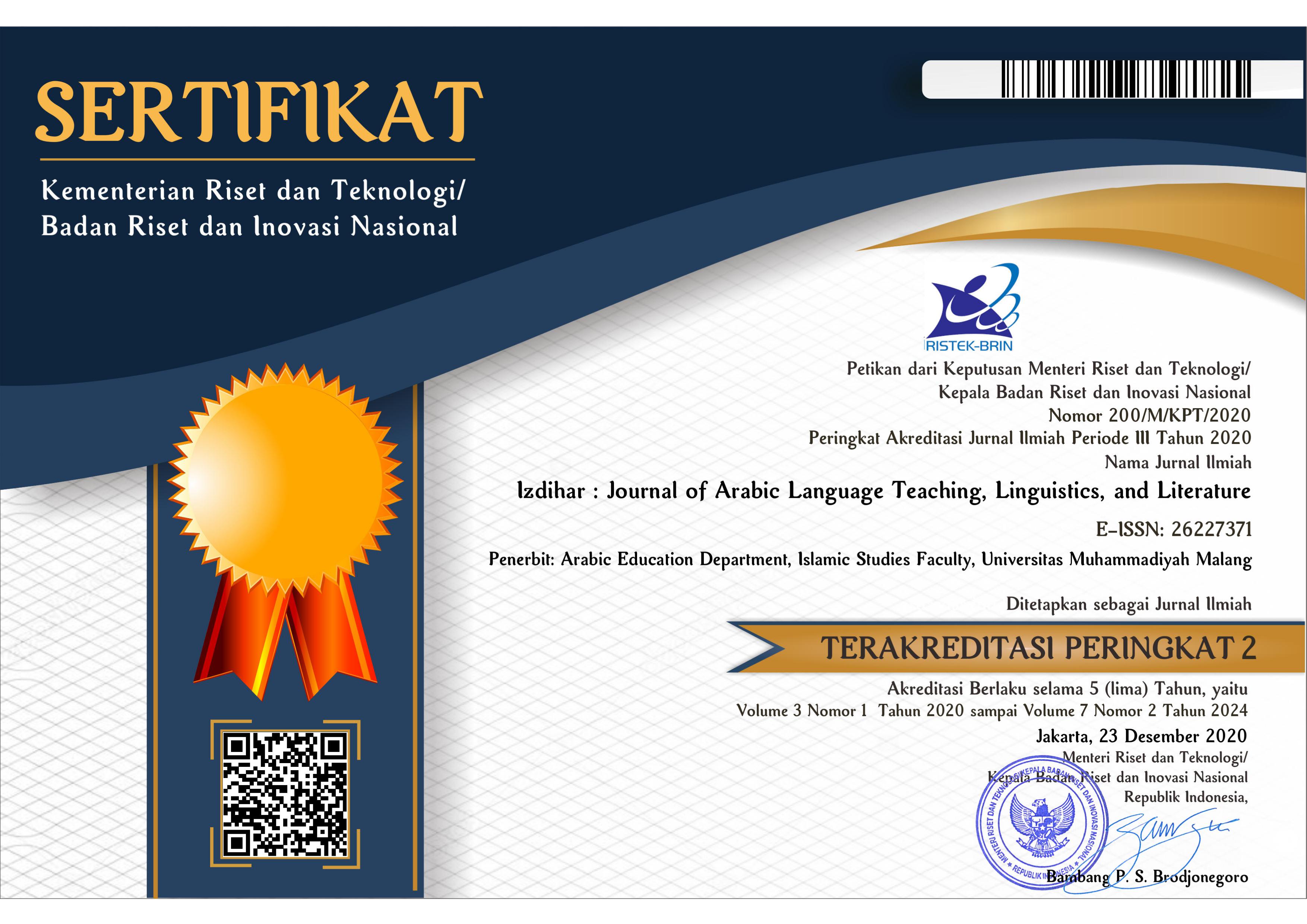The Learning of Arabic Alphabets for Special Needs Students in Elementary School
DOI:
https://doi.org/10.22219/jiz.v3i2.11931Keywords:
Arabic Alphabets, Learning, Student with Special NeedsAbstract
This research was motivated by the learning of Arabic letters in students with special needs as a basic stage of learning Arabic and the Qur’an. This study aimed to describe the learning of Arabic letters in students with special needs in elementary school Campurdarat Tulungagung East Java Indonesia.This type of research was descriptive qualitative. Data collection techniques by interview, observation, and documentation. Sources of data in this study were principals, teachers, students with special needs, and documents. The results of this study were descriptions of the learning of Arabic letters for students with special needs in elementary schools. (1) Learning planning included promissory notes, syllabus, and lesson plans like schools in general. (2) The implementation of learning included teaching materials with Islamic handbooks while learning methods included alphabetical methods, demonstrations, recitation, and lectures dominated by sign language, while the learning media included cards and Juz ‘Amma. (3) Evaluation of learning included evaluation of processes and results that show students with special abilities can identify Arabic letters, but difficulties in pronunciation.
Downloads
References
Agustia, R. D., & Arifin, I. N. (2018). Implementation of Visual, Auditory, Kineshthetic, Tactile Model Learning System to Help Mild Retarded Children in Alphabetical and Numeric Learning. IOP Conference Series: Materials Science and Engineering, 407(1), 1-7. DOI: https://doi.org/10.1088/1757-899X/407/1/012009
Ahmadi, A., & Supriyono, W. (2008). Psikologi Belajar. PT. Rineka Cipta.
Ainin, M. (2010). Metodologi Penelitian Bahasa Arab. Hilal Pustaka.
Prayoga, A., Dian, D., & Anwar, A. M. (2020). Strategi Peningkatan Kompetensi Pedagogik Pendidik dalam Penyusunan Rencana Program Pembelajaran. Al-Idarah: Jurnal Manajemen Pendidikan Islam, 5(1), 29-39. http://ejurnal-stitpringsewu.ac.id/index.php/jmpi/article/view/63
Arsyad, A. (2011). Media Pembelajaran. PT. Raja Grafindo Persada.
Bergeron, J. P., Lederberg, A. R., Easterbrooks, S. R., Elizabeth, E. D. ;, Miller, M., & Connor, C. M. (2009). Alphabetic Principle 87 The Volta Review. 109(3), 87–119. https://clad.education.gsu.edu/files/2016/05/Bergeron-et-al-2009-Alphabetic-Principle.pdf
Boudelaa, S., Perea, M., & Carreiras, M. (2020). Matrices of the frequency and similarity of Arabic letters and allographs. Behavior Research Methods. DOI: https://doi.org/10.3758/s13428-020-01353-z
Darling-Hammond, L., Flook, L., Cook-Harvey, C., Barron, B., & Osher, D. (2020). Implications for educational practice of the science of learning and development. Applied Developmental Science, 24(2), 97–140. DOI: https://doi.org/10.1080/10888691.2018.1537791
Delphie, B. (2006). Pembelajaran Anak Berkebutuhan Khusus (dalam setting pendidikan inklusi). Bandung: Refika Aditama.
Farris, E. A., Alexander, E. E., & Odegard, T. N. (2020). Assessment and identification of learning disabilities. The Clinical Guide to Assessment and Treatment of Childhood Learning and Attention Problems, 3–32. DOI: https://doi.org/10.1016/b978-0-12-815755-8.00001-0
Fellinger, J., Linzner, D., Holzinger, D., Dall, M., Fellinger, M., & Fogler, J. (2020). Development of Deaf Adults with Intellectual Disability in a Therapeutic Living Community. The Journal of Deaf Studies and Deaf Education, Volume 25(Issue 3), 261–269. DOI: https://doi.org/10.1093/deafed/enz056
Fitriyah, T., & Fauzi, M. F. (2020). Improving Quality of Arabic Translation Course through Jigsaw Cooperative Learning. Izdihar : Journal of Arabic Language Teaching, Linguistics, and Literature, 3(1), 17–30. DOI: https://doi.org/10.22219/jiz.v3i1.11033
Gumrowi, A. (2020). Mengembangkan Rencana Pelaksanaan Pembelajaran (RPP) Abad 21 melalui Individual Conference. Jurnal Ilmiah Indonesia p–ISSN: 2541-0849 e-ISSN : 2548-1398, 5(February 2019), 1–13. DOI: http://dx.doi.org/10.36418/syntax-literate.v5i1.851
Hamalik, O. (2007). Kurikulum dan Pembelajaran. Jakarta: Bumi Aksara.
Hidayat, T., & Asyafah, A. (2019). Konsep Dasar Evaluasi Dan Implikasinya Dalam Evaluasi Pembelajaran Pendidikan Agama Islam Di Sekolah. Al-Tadzkiyyah: Jurnal Pendidikan Islam, 10(1), 159–181. DOI: https://doi.org/10.24042/atjpi.v10i1.3729
Iskandar, S. (2019). Peningkatan Kinerja Guru dalam Pembelajaran Melalui Supervisi. Jurnal Dewantara, 5(1), 153–168. http://www.ejournal.iqrometro.co.id/index.php/pendidikan/article/view/109/90
Khalil, M. K., & Elkhider, I. A. (2016). Applying learning theories and instructional design models for effective instruction. Advances in Physiology Education, 40(2), 147–156. DOI: https://doi.org/10.1152/advan.00138.2015
Kyle, F. E., Campbell, R., & MacSweeney, M. (2016). The relative contributions of speechreading and vocabulary to deaf and hearing children’s reading ability. Research in Developmental Disabilities, 48, 13–24. https://doi.org/10.1016/j.ridd.2015.10.004
Lestari, W., & Zulmiyetri, Z. (2019). Meningkatkan Kemampuan Membaca Kata Melalui Media Video Pembelajaran Bagi Anak Tunarungu. Jurnal Penelitian Pendidikan Khusus, 7(1), 71–76. http://103.216.87.80/index.php/jupekhu/article/view/103014
Mulyana, D., & Wijiastuti, A. (2019). Kemampuan Pragmatik dalam Interaksi Sosial Anak Tunarungu Melalui Penggunaan Metode Komunikasi Total. 3, 22–25. DOI: https://doi.org/10.24036/jpkk.v3i2.541
Nuraeni, T., Mardiah, L. N., & Wiralodra, U. (2020). Bagaimanakah proses belajar anak tunarungu dan anak autisme?: studi kasus di salah satu slb di indramayu. Gema Wiralodra. 11(1), 133–142. DOI: https://doi.org/10.31943/gemawiralodra.v11i1.115
Pimada, L. H., Toba, R., & Rasyidi, A. W. (2020). Learning of Imla’ Using Flashcards on Writing Skill at Islamic Elementary School Level in Samarinda. Izdihar : Journal of Arabic Language Teaching, Linguistics, and Literature, 3(1), 1–16. DOI: https://doi.org/10.22219/jiz.v3i1.11682
Pudjiastuti, T. (2018). Peningkatan kemampuan membuat rpp tematik melalui pelatihan bagi guru slb-c satuan pendidikan sdlb semester ii tahun pelajaran 2017/2018. 4(1), 1–11. DOI: https://doi.org/10.31537/speed.v4i1.315
Rahmawati, M., Nugrahaeni, F., & Mauludiyah, L. (2020). Improving Arabic Speaking Skill through Mind Mapping Strategy. Izdihar : Journal of Arabic Language Teaching, Linguistics, and Literature, 3(1), 31–44. DOI: https://doi.org/10.22219/jiz.v3i1.10967
Ramadhan, F. C., Sumarto, S., & Abdullah, A. G. (2020). The use of visual multimedia in moto cycle mechanics training for deaf students. IOP Conference Series: Materials Science and Engineering, 830(3), 1-5. DOI: https://doi.org/10.1088/1757-899X/830/3/032055
Sum, T. A., & Taran, E. G. M. (2020). Kompetensi Pedagogik Guru PAUD dalam Perencanaan dan Pelaksanaan Pembelajaran. Jurnal Obsesi : Jurnal Pendidikan Anak Usia Dini, 4(2), 543-550. DOI: https://doi.org/10.31004/obsesi.v4i2.287
Suryapermana, N. (2017). Manajemen Perencanaan Pembelajaran. Tarbawi: Jurnal Keilmuan Manajemen Pendidikan, 3(02), 183-193. DOI: https://doi.org/10.32678/tarbawi.v3i02.1788
Susanto. (2015). Rencana Pelaksanaan Pembelajaran: Menyatu, Koheren, dan Operasional. Surabaya: CV Istana Grafika.
Susiloningsih, W. (2019). Analisis Pemahaman Konseptual Mahasiswa PGSD pada Mata Kuliah Perencanaan dengan Pendekatan Saintifik. Jurnal Basicedu, 3(2), 524–532. DOI: https://doi.org/10.31004/basicedu.v4i1.270
Wiyono, B. B., & Sunarni. (2009). Evaluasi Program Pendidikan dan Pembelajaran. Malang: FIP Universitas Negeri Malang.
Zuhairi. (2008). Pelaksanaan Pembelajaran. http://zuhairistain.blogspot.com/2008/11/pelaksanaan-pembelajaran.html
Downloads
Published
How to Cite
Issue
Section
License
Copyright Notice
Authors who publish with this journal agree to the following terms:
- Authors retain copyright and grant the journal right of first publication with the work simultaneously licensed under a Creative Commons Attribution-ShareAlike 4.0 International License that allows others to share the work with an acknowledgment of the work's authorship and initial publication in this journal.
- Authors are able to enter into separate, additional contractual arrangements for the non-exclusive distribution of the journal's published version of the work (e.g., post it to an institutional repository or publish it in a book), with an acknowledgment of its initial publication in this journal.
- Authors are permitted and encouraged to post their work online (e.g., in institutional repositories or on their website) prior to and during the submission process, as it can lead to productive exchanges, as well as earlier and greater citation of published work (See The Effect of Open Access).
Copyright (c) 2019 Izdihar : Journal of Arabic Language Teaching, Linguistics, and Literature

This work is licensed under a Creative Commons Attribution-ShareAlike 4.0 International License.

















